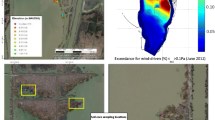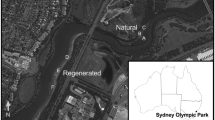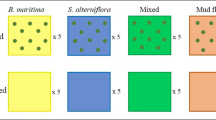Abstract
Recent salt marsh and barrier island restoration efforts in the northern Gulf of Mexico have focused on optimizing self-sustaining attributes of restored marshes to provide maximum habitat value and storm protection to vulnerable coastal communities. Salt marshes in this region are dominated by Spartina alterniflora and Avicennia germinans, two species that are valued for their ability to stabilize soils in intertidal salt marshes. We conducted a controlled greenhouse study to investigate the influences of substrate type, nutrient level, and marsh elevation on the growth and biomass allocation of S. alterniflora and A. germinans, and the consequent effects on soil development and stability. S. alterniflora exhibited optimal growth and survival at the lowest elevation (− 15 cm below the water surface) and was sensitive to high soil salinities at higher elevations (+ 15 cm above the water surface). A. germinans performed best at intermediate elevations but was negatively affected by prolonged inundation at lower elevations. We found that although there was not a strong effect of substrate type on plant growth, the development of stressful conditions due to the use of suboptimal materials would likely be exacerbated by placing the soil at extreme elevations. Soil shear strength was significantly higher in experimental units containing either S. alterniflora or A. germinans compared to unvegetated soils, suggesting that plants effectively contribute to soil strength in newly placed soils of restored marshes. As marsh vegetation plays a critical role in stabilizing shorelines, salt marsh restoration efforts in the northern Gulf of Mexico and other storm impacted coasts should be designed at optimal elevations to facilitate the establishment and growth of key marsh species.









Similar content being viewed by others
References
Airoldi L, Abbiati M, Beck M et al (2005) An ecological perspective on the deployment and design of low-crested and other hard coastal defense structures. Coast Eng 52:1073–1087
Alleman LK, Hester MW (2010) Refinement of the fundamental niche of black mangrove (Avicennia germinans) seedlings in Louisiana: applications for restoration. Wetl Ecol Manag 19:47–60. https://doi.org/10.1007/s11273-010-9199-6
Alleman LK, Hester MW (2011) Reproductive ecology of black mangrove (Avicennia germinans) along the Louisiana coast: propagule production cycles, dispersal limitations, and establishment elevations. Estuaries Coasts 34:1068–1077. https://doi.org/10.1007/s12237-011-9404-8
Blake G, Hartge K (1986) Bulk density. In: Klute A (ed) Methods of soil analysis, Part I. Physical and minerological methods: Agronomy Monograph no. 9. American Society of Agronomy, Madison, pp 363–375
Bouyoucos G (1951) A recalibration of the hydrometer method for making mechanical analysis of soils. Agron J 43:434–438
Broome SW (1989) Creation and restoration of tidal wetlands of the southeastern United States. In: Kusler JA, Kentula ME (eds) Wetland creation and restoration: the status of the science: regional reviews, vol 1. U.S. Environmental Protection Agency, Corvallis, pp 37–72
Broome SW, Craft CB (2000) Tidal salt marsh restoration, creation, and mitigation. In: Barnhisel RI, Darmody RG, Daniels WL (eds) Reclamation of drastically disturbed lands. American Society of Agronomy, Madison, pp 939–959
Brown CE, Pezeshki SR (2007) Threshhold for recovery in the marsh halophyte Spartina alterniflora grown under the combined effects of salinity and soil drying. J Plant Physiol 164:274–282. https://doi.org/10.1016/j.jplph.2006.01.002
Bulleri F, Chapman MG (2010) The introduction of coastal infrastructure as a driver of change in marine environments. J Appl Ecol 47:26–35. https://doi.org/10.1111/j.1365-2664.2009.01751.x
Callaway J (2001) Hydrology and substrate. In: Zedler J (ed) Handbook for restoring tidal wetlands. CRC Press, Boca Raton, pp 89–111
Callaway RM, Sabraw CS (1994) Effects of variable precipitation on the structure and diversity of a California salt marsh community. J Veg Sci 5:433–438. https://doi.org/10.2307/3235867
Campbell T, Benedet L, Finkl CW (2005a) Regional strategies for coastal restoration along Louisiana barrier islands. J Coast Res 44:245–267
Campbell T, Benedet L, Thomson G (2005b) Design considerations for barrier island nourishments and coastal structures for coastal restoration in Louisiana. J Coast Res 1:186–203
Chen R, Twilley RR (1999) A simulation model of organic matter and nutrient accumulation in mangrove wetland soils. Biogeochemistry 44:93–118
Craft CB (1996) Dynamics of nitrogen and phosphorus retention during wetland ecosystem succession. Wetl Ecol Manag 4:177–187. https://doi.org/10.1007/BF01879236
Ellison AM, Farnsworth EJ (1997) Simulated sea-level change alters anatomy, physiology, growth, and reproduction of red mangrove (Rhizophora mangle L.). Oecologia 112:435–446
Ewanchuk PJ, Bertness MD (2004) Structure and organization of a northern New England salt marsh plant community. J Ecol 92:72–85
Feagin RA, Lozada-Bernard SM, Ravens TM et al (2009) Does vegetation prevent wave erosion of salt marsh edges? Proc Natl Acad Sci USA 106:10109–10113. https://doi.org/10.1073/pnas.0901297106
Feagin RA, Figlus J, Zinnert JC et al (2015) Going with the flow or against the grain? The promise of vegetation for protecting beaches, dunes, and barrier islands from erosion. Front Ecol Environ 13:203–210. https://doi.org/10.1890/140218
Fearnley S (2008) The soil physical and chemical properties of restored and natural back-barrier salt marsh on Isles Dernieres, Louisiana. J Coast Res 24:84–94. https://doi.org/10.2112/05-0620.1
Feher LC, Willis JM, Hester MW (2018) Importance of site history and environmental setting on soil properties in restoration Louisiana back-barrier island salt marshes. J Coast Res 34:58–66. https://doi.org/10.2112/JCOASTRES-D-16-00149.1
Field CD (1998) Rehabilitation of mangrove ecosystems: an overview. Mar Pollut Bull 37:383–392
Gedan KB, Kirwan ML, Wolanski E et al (2011) The present and future role of coastal wetland vegetation in protecting shorelines: answering recent challenges to the paradigm. Clim Change 106:7–29. https://doi.org/10.1007/s10584-010-0003-7
Gyssels G, Poesen J, Bochet E, Li Y (2005) Impact of plant roots on the resistance of soils to erosion by water: a review. Prog Phys Geogr 29:189–217. https://doi.org/10.1191/0309133305pp443ra
Hemminga M, Kok C, de Munck W (1988) Decomposition of Spartina anglica roots and rhizomes in a salt marsh of the Westerschelde Estuary. Mar Ecol Prog Ser 48:175–184. https://doi.org/10.3354/meps048175
Henry KM, Twilley RR (2013) Soil development in a coastal Louisiana wetland during a climate-induced vegetation shift from salt marsh to mangrove. J Coast Res 29:1273–1283. https://doi.org/10.2112/JCOASTRES-D-12_00184.1
Hester MW, Mendelssohn IA, Mckee KL (2001) Species and population variation to salinity stress in Panicum hemitomon, Spartina patens, and Spartina alterniflora: morphological and physiological constraints. Environ Exp Bot 46:277–297
Hester M, Spalding E, Franze C (2005) Biological resources of the Louisiana coast: Part 1. An overview of coastal plant communities of the Louisiana gulf shoreline. J Coast Res 44:134–145
Howes NC, Fitzgerald DM, Hughes ZJ et al (2010) Hurricane-induced failure of low salinity wetlands. Proc Natl Acad Sci USA 107:14014–14019. https://doi.org/10.1073/pnas.0914582107
Justić D, Rabalais NN, Turner RE (1996) Effects of climate change on hypoxia in coastal waters: a doubled CO2 scenario for the northern Gulf of Mexico. Limnol Oceanogr 41:992–1003. https://doi.org/10.4319/lo.1996.41.5.0992
Kalra Y (1995) Determination of pH of soils by different methods: collaborative study. J AOAC Int 78:310–324
Khalil SM, Finkl CW, Roberts HH, Raynie RC (2010) New approaches to sediment management on the inner continental shelf offshore coastal Louisiana. J Coast Res 26:591–604. https://doi.org/10.2112/10A-00004.1
Khalil SM, Finkl CW, Raynie RC (2013) Development of new restoration strategies for Louisiana barrier island systems, northern Gulf of Mexico, USA. J Coast Res 65:1467–1472. https://doi.org/10.2112/SI65-248.1
Knutson P, Ford J, Inskeep M, Oyler J (1981) National survey of planted salt marshes (vegetative stabilization and wave stress). Wetlands 1:129–157
Krauss KW, Mckee KL, Hester MW (2014) Water use characteristics of black mangrove (Avicennia germinans) communities along an ecotone with marsh at a northern geographical limit. Ecohydrology 7:354–365. https://doi.org/10.1002/eco.1353
Kulp M, Penland S, Williams SJ, Jenkins C, Flocks J, Kindinger J (2005) Geologic framework, evolution, and sediment resources for restoration in the Louisiana coastal zone. J Coast Res 44:56–71
Lee RW, Kraus DW, Doeller JE (1999) Oxidation of sulfide by Spartina alterniflora roots. Limnol Oceanogr 44:1155–1159. https://doi.org/10.4319/lo.1999.44.4.1155
Lewis RR (2005) Ecological engineering for successful management and restoration of mangrove forests. Ecol Eng 24:403–418. https://doi.org/10.1016/j.ecoleng.2004.10.003
McKee KL (1996) Growth and physiological responses of neotropical mangrove seedlings to root zone hypoxia. Tree Physiol 16:883–889
McKee KL, Faulkner PI (2000) Restoration of biogeochemical function in mangrove forests. Restor Ecol 8:247–259
McKee KL, McGinnis TE (2002) Hurricane Mitch: effects on mangrove soil characteristics and root contributions to soil stabilization: USGS Open File Report 03-178, 57 p
Mendelssohn IA, McKee KL, Patrick WH (1981) Oxygen deficiency in Spartina alterniflora roots: metabolic adaptation to anoxia. Science 214:439–441
Mendelssohn IA, Hester MW, Monteferrante FJ, Talbot F (1991) Experimental dune building and vegetative stabilization in a sand-deficient barrier island setting on the Louisiana coast, USA. J Coast Res 7:137–149
Naidoo AG, McKee KL, Mendelssohn IA (1992) Anatomical and metabolic responses to waterlogging and salinity in Spartina alterniflora and S. patens (Poaceae). Am J Bot 79:765–770
Osland MJ, Spivak AC, Nestlerode JA et al (2012) Ecosystem development after mangrove wetland creation: plant–soil change across a 20-year chronosequence. Ecosystems 15:848–866. https://doi.org/10.1007/s10021-012-9551-1
Perry CL, Mendessohn IA (2009) Ecosystem effects of expanding populations of Avicennia germinans in a Louisiana coastal salt marsh. Wetlands 29:396–406. https://doi.org/10.1672/08-100.1
Pezeshki SR (2001) Wetland plant responses to soil flooding. Environ Exp Bot 46:299–312. https://doi.org/10.1016/S0098-8472(01)00107-1
Pezeshki SR, Delaune RD, Patrick WH Jr (1990) Differential response of selected mangroves to soil flooding and salinity: gas exchange and biomass partitioning. Can J For Res 20:869–874
Rasser MK, Fowler NL, Dunton KH (2013) Elevation and plant community distribution in a microtidal salt marsh of the western Gulf of Mexico. Wetlands 33:575–583. https://doi.org/10.1007/s13157-013-0398-9
Raynie R, Visser J (2002) CWPPRA adaptive management review final report. CWPPRA Planning and Evaluation Subcommittee, Technical Committee, and Task Force
Shumway SW, Bertness MD (1992) Salt stress limitation of seedling recruitment in a salt marsh plant community. Oecologia 92:490–497
Streever WJ (2000) Spartina alterniflora marshes on dredged material: a critical review of the ongoing debate over success. Wetl Ecol Manag 8:295–316
Turner RE (2011) Beneath the salt marsh canopy: loss of soil strength with increasing nutrient loads. Estuaries Coasts 34:1084–1093. https://doi.org/10.1007/s12237-010-9341-y
Turner RE, Howes BL, Teal JM et al (2009) Salt marshes and eutrophication: an unsustainable outcome. Limnol Oceanogr 54:1634–1642. https://doi.org/10.4319/lo.2009.54.5.1634
van Eerdt MM (1985) The influence of vegetation on erosion and accretion in salt marshes of the Oosterschelde, The Netherlands. Vegetatio 62:367–373
Wagner RJ (2000) Houston-Galveston navigation channel: blueprint for the beneficial uses of dredge material. Coast Manag 28:337–352
Wang Q, Wang S (2011) Response of labile organic matter to changes in forest vegetation in subtropical regions. Appl Soil Ecol 47:210–216
Watts CW, Tolhurst TJ, Black KS, Whitmore AP (2003) In situ measurements of erosion shear stress and geotechnical shear strength of the intertidal sediments of the experimental managed realignment scheme at Tollesbury, Essex, UK. Estuar Coast Shelf Sci 58:611–620. https://doi.org/10.1016/S0272-7714(03)00139-2
Whisenant S (1999) Repairing damaged wildlands: a process oriented, landscape-scale approach. Cambridge University Press, Cambridge
Woodhouse WW (1979) Building salt marshes along the coasts of the continental United States. U.S. Army Corps of Engineers, Coastal Engineering Research, Fort Belvoir
Subramanian B, Slear G, Smith K, Duhring K (2006) Current understanding of the effectiveness of nonstructural and marsh sill approaches. In: Living Shoreline Summit. CRC Press, Boca Raton
Zedler J (2005) Ecological restoration: guidance from theory. San Franc Estuary Watershed Sci 3:1–31
Zedler JB, Morzaria-Luna H, Ward K (2003) The challenge of restoring vegetation on tidal, hypersaline substrates. Plant Soil 253:259–273. https://doi.org/10.1023/A:1024599203741
Acknowledgements
Financial support for this study was provided by the Louisiana Barrier Island Comprehensive Monitoring Program (Louisiana CPRA Contract No. 2514-14-03), the Coastal Protection & Restoration Authority/Louisiana SeaGrant Coastal Science Assistantship Program, Coastal Plant Ecology Lab at University of Louisiana at Lafayette, University of Louisiana at Lafayette Graduate Student Association, and the Ecology Center at University of Louisiana at Lafayette.
Author information
Authors and Affiliations
Corresponding author
Rights and permissions
About this article
Cite this article
Feher, L.C., Hester, M.W. The interactive effects of created salt marsh substrate type, hydrology, and nutrient regime on Spartina alterniflora and Avicennia germinans productivity and soil development. Wetlands Ecol Manage 26, 715–728 (2018). https://doi.org/10.1007/s11273-018-9603-1
Received:
Accepted:
Published:
Issue Date:
DOI: https://doi.org/10.1007/s11273-018-9603-1




